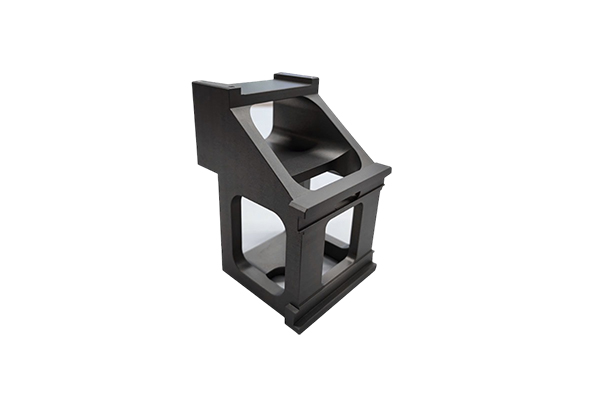How is the high strength of aerospace Hinge Link Parts achieved?
Release Time : 2024-10-23
The high strength of aerospace Hinge Link Parts is mainly achieved in the following ways:
1. Material selection
High-strength alloy materials: Aerospace hinges usually use high-strength metal alloy materials, such as aluminum alloy, titanium alloy or high-strength steel. These materials not only have good strength and toughness, but also have low density, which meets the strict weight requirements of spacecraft.
High-temperature resistant materials: In some special applications, hinges may require high-temperature resistant materials to ensure strength and performance under extreme temperature conditions.
2. Optimized design structure
Reasonable geometry: The design of aerospace hinges usually follows the principles of mechanics. Through the reasonable application of shape and structure, it can evenly distribute stress when bearing loads and reduce stress concentration.
Rib design: By adding ribs, ribs and other designs, the bending and torsion resistance of the hinge can be effectively improved, and the strength of the entire component can be improved.
3. Advanced manufacturing process
Precision machining: Use high-precision machining technology (such as CNC machining) to ensure the dimensional accuracy and surface finish of each hinge component, thereby reducing stress concentration caused by machining errors.
Heat treatment and surface treatment: The hinge components undergo appropriate heat treatment (such as quenching, tempering, etc.) and surface treatment (such as anodizing, coating, etc.), which not only improves the hardness and corrosion resistance of the material, but also improves the fatigue performance and wear resistance of the material.
4. Accurate assembly process
Precise centering and coordination: The assembly of the hinge must ensure the centering and coordination between the components to avoid stress concentration or wear caused by poor assembly.
High-strength fasteners: Use high-strength fasteners (such as high-strength screws, nuts, etc.) at the hinge joints to increase the fastening force of the connecting parts, which helps to improve the rigidity and tear resistance of the overall structure.
5. Testing and Verification
Strict performance testing: In the design and production of aerospace hinges, multiple performance tests (such as tensile testing, fatigue testing, environmental adaptability testing, etc.) are required to verify the reliability and strength of the hinges under extreme conditions.
Finite element analysis: In the design stage, modern engineering simulation technologies such as finite element analysis (FEA) are used to perform stress analysis, optimize design and material selection, and improve strength and durability.
6. Load sharing and distribution
Reasonable load layout: During the design process, mechanical analysis ensures that the load of the hinge can be reasonably distributed during operation to avoid excessive concentration in a certain part, thereby improving the overall load-bearing capacity of the structure.
The high strength of aerospace Hinge Link Parts is achieved through fine material selection, optimized design structure, reliable manufacturing process, and strict assembly and testing processes. These measures ensure that key components of spacecraft can maintain high strength and reliability in harsh environments and meet the high standards of safety and performance in the aerospace field.
1. Material selection
High-strength alloy materials: Aerospace hinges usually use high-strength metal alloy materials, such as aluminum alloy, titanium alloy or high-strength steel. These materials not only have good strength and toughness, but also have low density, which meets the strict weight requirements of spacecraft.
High-temperature resistant materials: In some special applications, hinges may require high-temperature resistant materials to ensure strength and performance under extreme temperature conditions.
2. Optimized design structure
Reasonable geometry: The design of aerospace hinges usually follows the principles of mechanics. Through the reasonable application of shape and structure, it can evenly distribute stress when bearing loads and reduce stress concentration.
Rib design: By adding ribs, ribs and other designs, the bending and torsion resistance of the hinge can be effectively improved, and the strength of the entire component can be improved.
3. Advanced manufacturing process
Precision machining: Use high-precision machining technology (such as CNC machining) to ensure the dimensional accuracy and surface finish of each hinge component, thereby reducing stress concentration caused by machining errors.
Heat treatment and surface treatment: The hinge components undergo appropriate heat treatment (such as quenching, tempering, etc.) and surface treatment (such as anodizing, coating, etc.), which not only improves the hardness and corrosion resistance of the material, but also improves the fatigue performance and wear resistance of the material.
4. Accurate assembly process
Precise centering and coordination: The assembly of the hinge must ensure the centering and coordination between the components to avoid stress concentration or wear caused by poor assembly.
High-strength fasteners: Use high-strength fasteners (such as high-strength screws, nuts, etc.) at the hinge joints to increase the fastening force of the connecting parts, which helps to improve the rigidity and tear resistance of the overall structure.
5. Testing and Verification
Strict performance testing: In the design and production of aerospace hinges, multiple performance tests (such as tensile testing, fatigue testing, environmental adaptability testing, etc.) are required to verify the reliability and strength of the hinges under extreme conditions.
Finite element analysis: In the design stage, modern engineering simulation technologies such as finite element analysis (FEA) are used to perform stress analysis, optimize design and material selection, and improve strength and durability.
6. Load sharing and distribution
Reasonable load layout: During the design process, mechanical analysis ensures that the load of the hinge can be reasonably distributed during operation to avoid excessive concentration in a certain part, thereby improving the overall load-bearing capacity of the structure.
The high strength of aerospace Hinge Link Parts is achieved through fine material selection, optimized design structure, reliable manufacturing process, and strict assembly and testing processes. These measures ensure that key components of spacecraft can maintain high strength and reliability in harsh environments and meet the high standards of safety and performance in the aerospace field.







